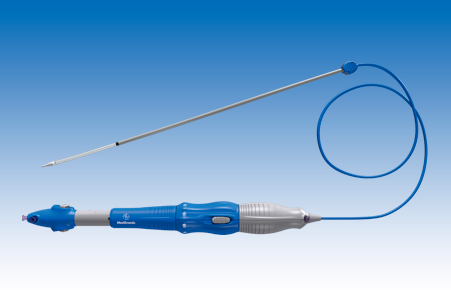Original Title: Treatment of Symptomatic Severe Aortic Stenosis with a Novel Resheathable Supra-Annular Self-Expanding Transcatheter Aortic Valve System.
Reference: Ganesh Manoharan et al. J Am Coll Cardiol Intv. 2015; 8(10):1359-1367.
Courtesy of Dr. Agustín Vecchia.

Since the first valves first came out, these devices have progressively been improved with a view to mitigating these shortcomings. The Evolut R comes with a new delivery system (EnVeo R) reduced in diameter. Both skirt and sheath are made of porcine pericardium, and it has a nitinol frame.
The aim of this study (prospective, international, single-arm) was to assess the safety and efficacy of Medtronic’s new CoreValve Evolut R. To this end, researchers included 60 patients with severe aortic stenosis regarded by a heart team as high or extremely high surgical risk.
26 or 29 mm devices were used according to annulus diameter per multislice CT (26 mm: 62.8 to 72.3 mm; 29 mm: 72.3 to 81.6 mm). As primary safety end point, mortality and stroke were assessed at 30 days. As regards valve performance, it was assessed by ARC-2 (Valve Academic Research Consortium-2), which consists of meeting the three criteria:
- No procedure-related mortality
- Correct positioning of the only valve
- Correct performance: no mismatch, mean gradient lower than 20 mmHg or peak velocity higher than 3 m/sec, absence of moderate/severe leak.
Also the percentage of patients with mild or less aortic regurgitation were evaluated between 24 hrs. and 7 days after procedure. 66.7% of patients were women, mean age was 82.8 ± 6.1 years, STS was 7.0 ± 3.7%, the femoral approach was used in 98.3% of patients, and the 29 mm device was used in 68.3% of patients.
All attempts at repositioning the valve were successful. There were no strokes or deaths at 30 days. Success rate according to VARC-2 was 78.6%. Paravalvular regurgitation was mild or less in 96.6% of patients and moderate in 3.4% at 30 days. There were no cases of severe leak. Major vascular complications presented in 8.3% of patients. 11.7% required definite pacemaker implantation.
Conclusion
This new device is safe and effective. Repositioning was possible in all cases, whenever required, and complications rate was low.
Editorial Comment
The present work shows very good performance of the new Medtronic device. The main differences with the earlier device are reduced delivery diameter and a pericardium skirt to reduce paravalvular leak. Only 5 patients had vascular complications: 3 cases of puncture site bleeding that required transfusion, one complication associated to a closure device and a femoral dissection (these two successfully treated with femoral PCI).
As regards the need for permanent pacemaker, it was significantly associated with valve positioning; those that required pacemakers had:
- Left coronary cusp 9.4 ± 3.1 mm
- Noncoronary cusp 8.1 ± 3.5 mm. vs. those that did not need pacemaker: left 4.3 ± 2.5 mm;
- Noncoronary 3.3 ± 2.5 mm.
P was significant for both comparisons (p < 0.0001). Furthermore, out of 7 patients that required pacemaker implantation, 4 had prior conduction conditions.
Courtesy of Dr. Agustín Vecchia. German Hospital, Buenos Aires, Argentina.
We value your opinion. You are more than welcome to leave your comments, thoughts, questions or any ideas here below.





